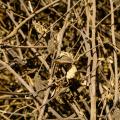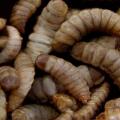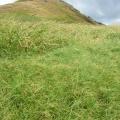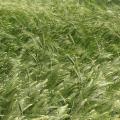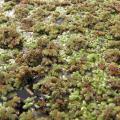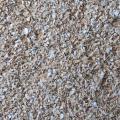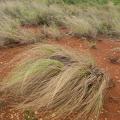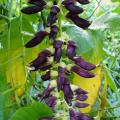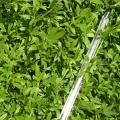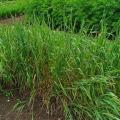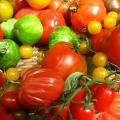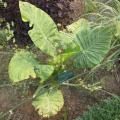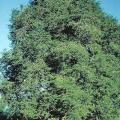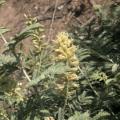Feedipedia news
Feedipedia will participate next week in the Global Forum for Animal Feed and Feed Regulators convened by the Food and Agriculture Organization (FAO) in Rome. Our team will deliver a presentation on the afternoon of 2 October titled Innovative protein and feed sourcing: an ongoing EU concern and will host a side event during lunch on 3 October entitled Feedipedia: Knowledge for All, Supported by All?
Explore Feedipedia
|
The cotton harvest leaves several residues in the field, such as stalks, side branches,... Read more |
The Caribbean stylo (Stylosanthes hamata (L.)Taub.) is a semi-erect, annual or... Read more |
The black soldier fly (Hermetia illucens Linnaeus 1758) is a fly (Diptera) of... Read more |
|
Bermuda grass (Cynodon dactylon Pers.) is a major tropical grass found in all... Read more |
Barley (Hordeum vulgare L.) is a major cereal crop primarily grown for... Read more |
Azolla (Azolla sp.) is an aquatic fern consisting of a short, branched, floating... Read more |
|
Yellow thatching grass (Hyperthelia dissoluta (Nees ex Steud.) Clayton) is a... Read more |
Wheat grain (Triticum spp.) is a major staple food that provides about 20% of... Read more |
Wheat (Triticum aestivum L.) is generally thought as a grain crop, but it can be... Read more |
|
Wheat bran, a by-product of the dry milling of common wheat (Triticum aestivum L... Read more |
Weeping love grass (Eragrostis curvula (Schrad.) Nees.) is a wiry, tufted... Read more |
The water hyacinth (Eichhornia crassipes (Mart.) Solms) is a free floating... Read more |
|
Manila tamarind (Pithecellobium dulce (Roxb.) Benth.) is a small to medium-sized... Read more |
Velvet bean (Mucuna pruriens (L.) DC. var. utilis (Wall. ex Wight)... Read more |
Townsville stylo (Stylosanthes humilis (Kunth) Hester) is a low growing annual (... Read more |
|
Tomato seeds, a by-product of tomato processing (cannery, tomato paste, tomato juice, etc... Read more |
Timothy grass (Phleum pratense) is a cool-season perennial grass from temperate... Read more |
Tomato (Lycopersicon esculentum Mill.) fruits that do not meet grade standards... Read more |
|
The taro (Colocasia esculenta (L.) Schott) is an herbaceous perennial, mostly... Read more |
The tamarind (Tamarindus indica L.) is a usually evergreen legume tree. It grows... Read more |
Syrian mesquite (Prosopis farcta (Banks & Sol.) J. F. Macbr) is a woody... Read more |
Pages
Recent resources
 Opinion paper: Phasing out of the aid provided to the livestock sector during expectedly recurrent emergencies
- Makkar, 2024. animal
Opinion paper: Phasing out of the aid provided to the livestock sector during expectedly recurrent emergencies
- Makkar, 2024. animal
Open access opinion paper that makes a case that the emergency aid do more harm than good to African countries. It is valid for all the fields of agriculture but has direct consequence for animal agriculture. The context here is the aid provided during emergencies that are foreseeable recurrent.
The role of livestock in food security, poverty reduction and wealth creation in West Africa
- Molina-Flores et al., 2020. Food and Agriculture Organization of the United Nations Accra, 2020
Livestock is key to 377 million people in West Africa and in some countries, up to 60% of the population is involved in livestock production. The demand for animal products is increasing with population growth, urbanization, growing middle class, and due to shifting consumer preferences towards animal products. To meet this growing demand, countries in West Africa must engage in accelerated sustainable livestock production undertaking. Livestock development is key to eradicate hunger and poverty. This book attempts to provide up-to-date, and reliable information on the potentials, opportunities, and challenges of the livestock subsector in West Africa.
Pulses and their by-products as animal feed
- Sherasia et al., 2017. In: Calles, T.; Makkar, H. P. S. (Eds), FAO, Food and Agriculture Organization of the United Nations, Rome, Italy
This document provides a state-of-the-art review of the recent research (published and unpublished) on the use of pulses and their by-products as animal feed. It aims at raising awareness on the use of pulses and their by-products. It highlights the nutritional role of pulses and pulse by-products as animal feed and is a contribution to the legacy of the 2016 International Year of Pulses. This document will further enhance the use of these feed resources in other continents, besides Asia, where many pulse by-products are simply dumped. It is also expected that the synthesis presented contributes to make the use of pulses and their by-products as animal feed more efficient. This document will be useful for extension workers, researchers, feed industry, policy-makers and donors alike.











